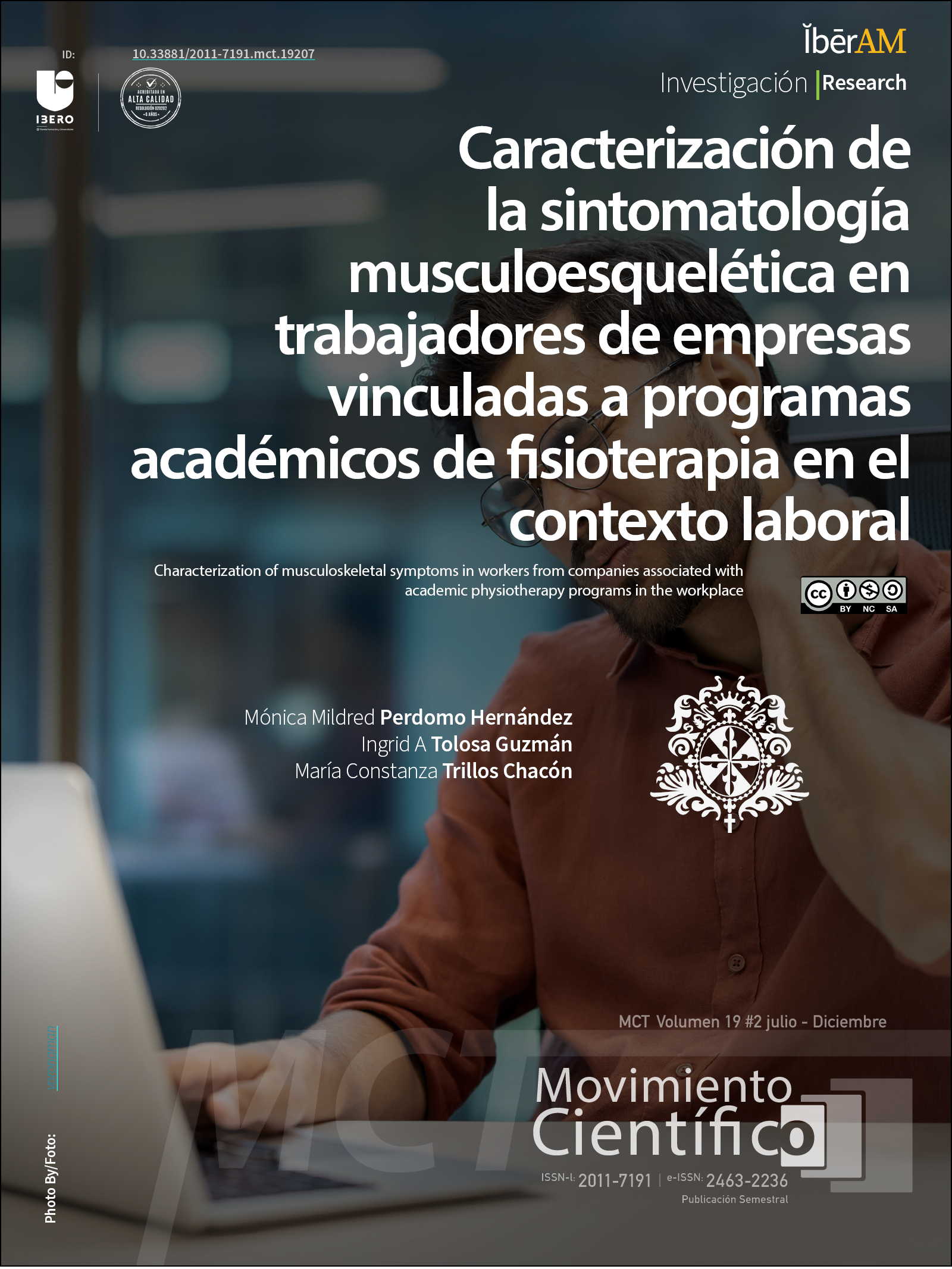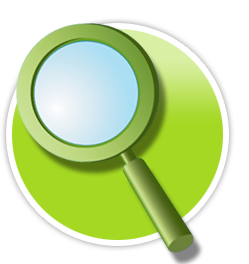Characterization of musculoskeletal symptoms in employees of companies affiliated with academic physical therapy programs in the workplace
Caracterización de la sintomatología musculoesquelética en trabajadores de empresas vinculadas a programas académicos de fisioterapia en el contexto laboral
Main Article Content
Introduction: "Musculoskeletal disorders" (MSDs) encompass a wide range of conditions, both inflammatory and degenerative, that affect various tissues of the musculoskeletal system. The disorders can cause pain and restrict an individual's work capacity, so the presence of combined risks in the work environment can increase the prevalence of DMEs. Objective: To characterize the musculoskeletal symptoms and biomechanical dangers in workers of academic field practices (PAC) in the Health and Work area of the Physiotherapy Program of the Universidad del Rosario. Methodology: This research was carried out in three companies from different economic sectors (manufacturing, food and cosmetics) where physiotherapy students from the Universidad del Rosario carried out the PAC in the area of Health and Work, using the Nordic questionnaire, which facilitates the recognition of the felt morbidity of the musculoskeletal system through the worker's perception; the ErgoIBV software, specifically through the use of the ErgoCheck category, which allows the qualitative and direct identification of occupational risks associated with non-ergonomic conditions and psychosocial factors. Results: The three companies have a high percentage of workers with a probability of ergonomic risk; being for the food and restaurant company (100%), cosmetics with (88%) and packaging manufacturing in a lower percentage with (85%). In the forced posture/repetitive task category, it is possible to see how the food and restaurant company is exposed with (100%), the packaging manufacturing company with (95%) and the cosmetics company with (88%); which may be associated with the imposed work pace (online work), lack of autonomy, repetitive and monotonous work. Conclusions: The study carried out in the three companies where the academic field practices (PAC) are developed, individual risk factors such as age, gender, biomechanical and psychosocial dangers are evident, which may be associated with the neuromusculoskeletal symptoms manifested. by the collaborators, which is corroborated with the reports provided in the scientific evidence where it is argued from the different theories of DMEs that these are of multifactorial origin; For this reason, a comprehensive approach must be carried out that allows prioritizing the dangers and thus establishing intervention strategies that allow reducing and controlling the risks by developing prevention and promotion activities.
Publication Facts
Reviewer profiles N/A
Author statements
Indexed in
-
—
- Academic society
- N/A
- Publisher
- Bogotá: Corporación Universitaria Iberoamericana
Article Details
Álvarez Casado, E., Hernández Soto, A., Tello Sandoval, S., Gil Meneses, R (2013). Guía para la evaluación rápida de riesgos ergonómicos. Secretaria de Política Sindical - Salut Laboral Barcelona.
Asociación Médica Mundial. (s/f). WMA - The World Medical Association-Declaración de Helsinki de la AMM – Principios éticos para las investigaciones médicas con participantes humanos. Recuperado el 19 de marzo de 2025, de https://www.wma.net/es/policies-post/declaracion-de-helsinki-de-la-amm-principios-eticos-para-las-investigaciones-medicas-en-seres-humanos/
Báez Colorado, A., Ascencio Ramírez, Z., & Avellaneda Ramírez, V. (2015). Prevalencia de patologías osteomusculares del miembro superior y su relación con factores ocupacionales en trabajadores de una empresa de flores. Bogotá 2015 [Universidad del Rosario]. http://repository.urosario.edu.co/handle/10336/11853
Cepeda Hilarión, A., Jiménez Chisica, G., & Ramírez Montes, A. L. (2019). Prevalencia de síntomas musculo esqueléticos y factores asociados en una empresa de alimentos de la ciudad de Bogotá, Colombia, 2019 [Universidad del Rosario]. https://doi.org/10.48713/10336_20633
Consejo de Organizaciones Internacionales de las Ciencias Médicas (CIOMS) (with Organización Panamericana de la Salud (OPS)). (2017). Pautas éticas internacionales para la investigación relacionada con la salud con seres humanos. https://cioms.ch/wp-content/uploads/2017/12/CIOMS-EthicalGuideline_SP_INTERIOR-FINAL.pdf
Cuesta Azcuna, R. (2014). Análisis ergonómico de una línea de Producción de la Fábrica de L´Oréal con la aplicación informática ErgoEval [Master, Universidad de Valladolid]. https://research.ebsco.com/linkprocessor/plink?id=fff1926f-d37e-38f3-a55b-45c1c610d699
Franco Enríquez, J. G., Meléndez Ortiz, L., Valdovinos Carrasco, N., Gómez González, Á., & Gaona, E. (2016). Análisis de la salud en el trabajo en una empresa de cosméticos en México. Salud de los Trabajadores, 24(2), 105–120.
Habib, Md. M., Yesmin, S., & Moniruzzaman. (2015). A pilot study of prevalence and distributions of musculoskeletal symptoms (MSS) among paper based office workers in Bangladesh. Work, 50(3), 371–378. https://doi.org/10.3233/WOR-151993
Hernández-Duarte, W. A. Desórdenes musculoesqueléticos, factores asociados y revisión de literatura para su intervención según género. Rev Bras Med, 2, 13.
Ibacache Araya, J. (2020). Cuestionario nórdico estandarizado de percepción de síntomas músculo esqueléticos. Departamento Salud Ocupacional Instituto de Salud Pública de Chile. https://www.ispch.cl/sites/default/files/NTPercepcionSintomasME01-03062020A.pdf
Jia, N., Zhang, M., Zhang, H., Ling, R., Liu, Y., Li, G., Yin, Y., Shao, H., Zhang, H., Qiu, B., Li, D., Wang, D., Zeng, Q., Wang, R., Chen, J., Zhang, D., Mei, L., Fang, X., Liu, Y., … Wang, Z. (2022). Prevalence and risk factors analysis for low back pain among occupational groups in key industries of China. BMC Public Health, 22(1), 1493. https://doi.org/10.1186/s12889-022-13730-8
Leguizamón Soto, L. Y., Bravo Becerra, A. M., & Cárdenas Serrano, D. C. (2020). Factores de riesgos biomecánicos y sintomatología musculo esquelética en trabajadores del área operativa de una empresa en Cúcuta, 2020 [Universidad de Santande]. https://repositorio.udes.edu.co/entities/publication/9a10c0c3-5325-4675-90ef-0cd4cc2b8873
Ministerio de Salud y Protección Social. (1993). Resolución numero 8430 de 1993. https://www.minsalud.gov.co/sites/rid/lists/bibliotecadigital/ride/de/dij/resolucion-8430-de-1993.pdf
OMS. (2021, febrero 8). Trastornos musculoesqueléticos. https://www.who.int/es/news-room/fact-sheets/detail/musculoskeletal-conditionsSE
OSHA. (s/f). Trastornos musculoesqueléticos | Safety and health at work EU-OSHA. Recuperado el 19 de marzo de 2025, de https://osha.europa.eu/es/themes/musculoskeletal-disorders
Paredes Rizo, M. L., Vázquez Ubago, M., Paredes Rizo, M. L., & Vázquez Ubago, M. (2018). Estudio descriptivo sobre las condiciones de trabajo y los trastornos musculo esqueléticos en el personal de enfermería (enfermeras y AAEE) de la Unidad de Cuidados Intensivos Pediátricos y Neonatales en el Hospital Clínico Universitario de Valladolid. Medicina y Seguridad del Trabajo, 64(251), 161–199.
Pineda Granados, F. Y., Gutiérrez-Strauss, A. M., & Gómez, C. (2022). Tercera Encuesta Nacional De Condiciones De Seguridad Y Salud En El Trabajo En El Sistema General De Riesgos Laborales. https://www.academia.edu/120653968/TERCERA_ENCUESTA_NACIONAL_DE_CONDICIONES_DE_SEGURIDAD_Y_SALUD_EN_EL_TRABAJO_EN_EL_SISTEMA_GENERAL_DE_RIESGOS_LABORALES
Ponce Bravo, G. (2022). Caracterización de la enfermedad laboral 2022. Revista Fasecolda, 188, Article 188.
Ruiz Barrios, A. S., Becerra delLlano, M. F., Islas Muñoz, V. L., Hernández Valle, V., García Medina, N. E., & Téllez Girón Solís, P. (2022). Identificación del nivel de riesgo ergonómico por manejo de cargas y movimientos repetitivos en industria alimentaria. Lux Médica, 17. https://doi.org/10.33064/51lm20223507
Tembo, L. N., Munyikwa, J. P., Musoro, C., Majonga, G., & Mavindidze, E. (2023). Prevalence of work-related musculoskeletal disorders and associated factors among University of Zimbabwe Faculty of Medicine and Health Sciences non-academic workers: A cross-sectional study. BMC Musculoskeletal Disorders, 24(1), 1–13. https://doi.org/10.1186/s12891-023-06900-1
Tran, T. T. T., Phan, C. T. T., Pham, T. C., & Nguyen, Q. T. (2016). After-shift Musculoskeletal Disorder Symptoms in Female Workers and Work-related Factors: A Cross-sectional Study in a Seafood Processing Factory in Vietnam. AIMS public health, 3(4), 733–749. https://doi.org/10.3934/publichealth.2016.4.733
World Health Organization. (2023, junio 19). Low back pain. https://www.who.int/news-room/fact-sheets/detail/low-back-pain
Yang, F., Di, N., Guo, W., Ding, W., Jia, N., Zhang, H., Li, D., Wang, D., Wang, R., Zhang, D., Liu, Y., Shen, B., Wang, Z., & Yin, Y. (2023). The prevalence and risk factors of work related musculoskeletal disorders among electronics manufacturing workers: A cross-sectional analytical study in China. BMC Public Health, 23(1), 10. https://doi.org/10.1186/s12889-022-14952-6















